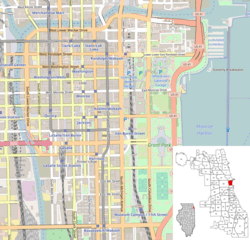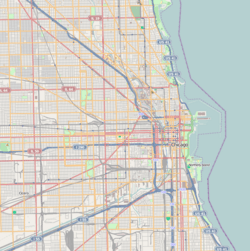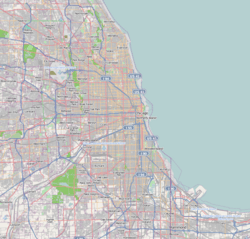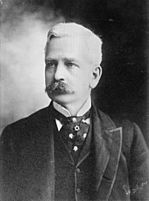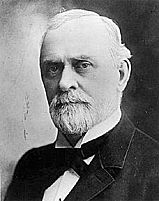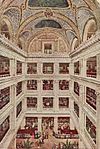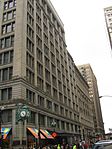Marshall Field and Company Building facts for kids
|
Marshall Field and Company Building
|
|
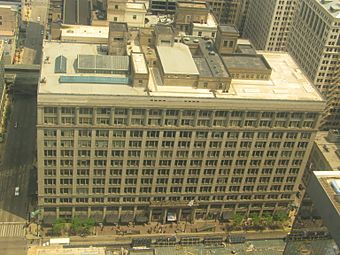
Marshall Field and Company Building
|
|
| Location | 111 North State Street, Chicago, Illinois |
|---|---|
| Built | 1891–1892 |
| Architect | Daniel H. Burnham |
| Architectural style | Chicago |
| NRHP reference No. | 78001123 |
Quick facts for kids Significant dates |
|
| Added to NRHP | June 2, 1978 |
| Designated NHL | June 2, 1978 |
The Marshall Field and Company Building is a famous building in Chicago, Illinois. It was once the main store for Marshall Field's, a well-known chain of department stores. Today, it is home to Macy's State Street.
This huge building was constructed in two main parts. The northern section was finished in 1901–02, and the southern part in 1905–06. It covers an entire city block in the "Loop" area of downtown Chicago. The building is bordered by North State Street, East Randolph Street, North Wabash Avenue, and East Washington Street.
Marshall Field's was a very important store. It was one of the first to do many things that department stores do today. Many people see it as one of the most important stores in the history of shopping in the United States. In 2006, the store changed its name to Macy's. This happened after Marshall Field's joined with Federated Department Stores.
The Marshall Field and Company Building is the third largest store in the world. It was named a National Historic Landmark in 1978. It also became a Chicago Landmark in 2005. The building is famous for its beautiful inside areas called atria. It also has a stunning Louis Comfort Tiffany mosaic ceiling. Two large clocks on the outside corners have been symbols of the store since 1897.
Contents
A Look at the Store's History


The store we know as Marshall Field's started in 1852 as P. Palmer & Co. Over the years, it changed names five times. In 1868, Potter Palmer convinced Marshall Field and Levi Leiter to move their store to State Street. This location, at the corner of Washington Street, became very important.
The store building was destroyed by the "Great Chicago Fire" in 1871. It was rebuilt, but then another fire destroyed it in 1877. Marshall Field bought the land and built a new store there in 1879. The business has been at this same spot ever since. Over time, four more buildings were added to create the large structure we see today.
State Street became the main shopping area in Chicago after the 1871 fire. Marshall Field's was a key part of this shopping district. As cities grew, Marshall Field's opened new stores in suburban areas. This helped the company stay competitive.
In 2006, Marshall Field's became Macy's. This change meant that some famous designer brands left the store. Many people in Chicago were sad about the name change. They protested because Marshall Field's had been a part of Chicago for over 150 years.
How Marshall Field's Changed Shopping
Marshall Field's was famous for setting new rules in retail. The company quickly became very successful. By the 1880s, it was one of the biggest stores in the country. Before Marshall Field died in 1906, his company was the largest wholesale and retail dry goods business in the world.
The store was the first to offer a bridal registry. It also had the first restaurants inside a store. Marshall Field's was also the first to have a European buying office. This meant they could bring unique items from other countries. They even offered personal shopping assistants to help customers.
Marshall Field was also the first merchant to clearly show the price of goods. Before this, people would often haggle over prices. He also had a famous slogan:
Give the lady what she wants.
This meant that customers could return anything they bought if they were not happy. This idea came from his early partner, Potter Palmer.
Building Details and Design
The Marshall Field and Company Building is made of granite and has 13 stories. It was built in different parts between 1902 and 1914. The famous architect Daniel Burnham designed the main sections along State Street. For a while, this building was the largest store in the world. It had over 73 acres (about 300,000 square meters) of floor space! It also had the biggest book, china, shoe, and toy departments of any store.
The building has several amazing inside spaces called atria. One of the most famous is in the southwest corner. It has a beautiful 5-story high ceiling made of Louis Comfort Tiffany mosaic glass. This ceiling is over 6,000 square feet (557 square meters) and has 1.6 million pieces of colorful glass. It took 50 artists 18 months to create! It was the first dome made of iridescent glass and is still the largest glass mosaic of its kind.
The building also has four huge 50-foot (15-meter) tall granite columns on its State Street side. These columns are similar to those found in ancient temples. The building is about 150 feet (46 meters) tall.
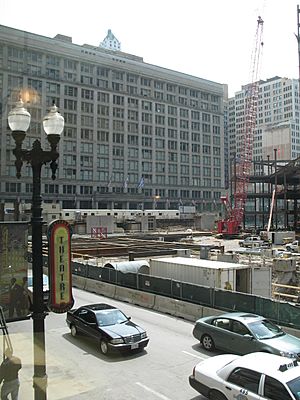
The building is also known for its two large clocks on the outside. These clocks weigh about 7.5 short tons (6.8 metric tons) each. They are located on the northwest and southwest corners along State Street. The clock at the Washington Street corner, called "The Great Clock," was put up in 1897.
Marshall Field wanted the clock to be a meeting point for people. Before the clock, people would leave notes for each other on the store windows. The clock was meant to stop this practice and encourage people to be on time.
Today, the building is at 111 North State Street. It is a major part of the "Chicago Pedway", an underground walkway system.
Gallery
-
Disassembled Dolce and Gabbana Collection during conversion from Marshall Field's to Macy's
-
Detail of the "Great Clock" on the corner of the Marshall Field & Company Building, built 1891–1892, at North State and Washington Streets, erected 1897
-
The "Great Clock" on the corner of the Marshall Field & Company Building of 1891–1892, above a crowd of pedestrians at North State and Washington Streets, erected 1897
Images for kids
See also
 In Spanish: Marshall Field and Company Building para niños
In Spanish: Marshall Field and Company Building para niños


